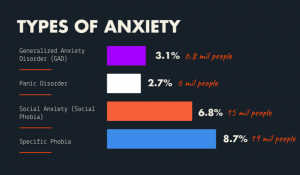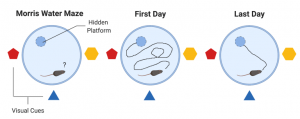Anxiety can be characterized by many different symptoms an individual my experience. From nervousness when talking in front of a large crowed to test taking, these stressful situations can significantly increase and interfere with daily activities. When this occurs, individuals may experience excessive worry, emotional distress, and severe anxiety. Such symptoms are diagnosed as generalized anxiety disorder. In the United States, 40 million adults experience some form of anxiety disorder, most starting before they even turn 21 years old. 
Figure 1.
This number doesn’t specifically refer to the generalized anxiety disorder prevalence, but it does provide an overview of the commonality of anxiety disorders. That being said, there are many types of anxiety that individuals may experience, from generalized anxiety disorder, panic disorder, social anxiety, and specific phobia. Theses are the top leading types of anxiety experienced by people today.
In order to come up with these diagnoses scientists must perform studies an animal models in order to find a baseline for symptoms of anxiety. One way researchers can do this is by conducting a Morris water maze test. Morris water maze test is a conduct strategy generally utilized with rodents. It is generally utilized to conduct spatial learning and memory. It empowers learning, memory, and spatial attempting to concentrate with extraordinary exactness, and can likewise be utilized to survey harm to specific cortical areas of the cerebrum. It is utilized by neuroscientists to quantify the impact of neurocognitive problems on spatial learning and conceivable neural medicines, to test the impact of sores to the mind in territories worried about memory, and to concentrate on how age impacts intellectual capacity and spatial learning. The errand is additionally utilized as an apparatus to consider drug misuse, neural frameworks, synapses, and mental health.

Figure 2.
There are three phrases used to test the Morris water maze:
Training phase-
Escape latency is how much time it takes to find the platform
Wall hugging can measure the rat not learning or anxiety
Swim speed can measure how drugs change swim speed and how long it takes to find the platform
Swim pattern shows the search strategy
Probe trial-
Time in target-the removal of the platform can see if the rat is using a strategy to find the general area of the platform when it doesn’t know where it is vs. the rat knowing where it is using a special strategy
Quadrant-
Tracks how much time the rat spends on the platform
The Morris water maze test is one of the most regularly utilized conduct tests to quantify spatial learning in rodents, including rodents and ordinary and hereditarily adjusted mice. It was first evolved and revealed by Richard G. Morris to test the spatial learning conduct of rats. He demonstrated that a hippocampal injury would weaken spatial learning. The test device comprises of a roundabout water tank filled with hazy water and a shrouded stage submerged a couple of centimeters under the water surface in one quadrant of the tank. The tank is encircled by viewable signals. Preparing the creatures to find the concealed stage may take a couple of days (normally 5–7 days). In each preparation preliminary, the test creature is permitted to swim in the water for 5 minutes to locate the shrouded stage. On the off chance that the creature doesn’t discover the stage within the 5-minute time frame, it is safeguarded and set on the stage. Every creature at that point goes through 5 minutes on the stage before being gotten back to its home cage. Every creature has five instructional courses a day. Given that the stage is covered up, the creature must figure out how to utilize the viewable signals encompassing the pool to find the stage. As preparation advances, the time used to locate the shrouded stage will ordinarily diminish. Such diminished break latencies will most regularly mirror the reception of a central inquiry methodology for creatures with no disability in spatial learning. Notwithstanding decreased getaway latencies may likewise mirror the selection of non-spatial methodologies (e.g., mice may figure out how to swim in concentric circles a fixed good way from the divider). In this manner, to separate spatial and non-spatial systems, mice are normally given a test, where the stage is eliminated from the pool, and the mouse is permitted to look for it, commonly over a 60-second time span. Mice having received a spatial procedure will center their pursuit close to the previous area of the stage.